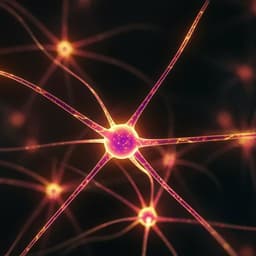
Psychology
Topoisomerase 3β knockout mice show transcriptional and behavioural impairments associated with neurogenesis and synaptic plasticity
Y. Joo, Y. Xue, et al.
Discover the pivotal role of Topoisomerase 3β (Top3β) in brain health and psychiatric disorders, as revealed by groundbreaking research from Yuyoung Joo and colleagues at the National Institute on Aging. Their studies show how Top3β knockout mice display behavioral phenotypes linked to cognitive impairments and disrupted neuronal activity. Unlock the secrets behind the neuronal functions that could lead to innovative treatments for mental health challenges.
~3 min • Beginner • English
Introduction
Topoisomerase 3β (Top3β) is a Type IA topoisomerase with unique dual activity on both DNA and RNA. It forms a conserved complex with the Tudor-domain protein TDRD3, and has been implicated in transcriptional regulation via R-loop resolution and in translational regulation through interaction with the RNA-binding protein FMRP. Human genetic studies associate TOP3B disruptions with neurodevelopmental and psychiatric conditions, including schizophrenia, autism spectrum disorder, epilepsy, intellectual disability, and cognitive impairment. However, causality and mechanisms remained unclear, and direct evidence that Top3β regulates neuronal transcription was lacking. Other topoisomerases, notably Top1 and Top2β, are essential for transcription of long and activity-regulated neuronal genes and for neuronal survival, with Top2β required for neuronal activity-dependent transcription (NADT) of early-response genes. Because neuronal activity induces rapid, widespread transcription of mRNAs and enhancer RNAs, creating acute topological stress, the authors hypothesized that Top3β is required to resolve this stress and support NADT. They tested this by analyzing behavior, hippocampal neurogenesis and synaptic function, and genome-wide transcriptional responses to fear conditioning in Top3β knockout mice.
Literature Review
Prior work showed that the Top3β–TDRD3 complex is recruited to promoters (e.g., c-myc) to reduce R-loops and stimulate transcription in cell lines, with TDRD3 knockdown or knockout elevating R-loops and reducing transcription, though similar direct evidence for Top3β had been lacking. Top3β associates with FMRP to promote mRNA translation and synapse formation, and also participates in heterochromatin formation via RNAi machinery in Drosophila. Human genetic studies link deletions or de novo variants in TOP3B to schizophrenia, autism, epilepsy, and cognitive impairment, including in the 22q11.2 distal deletion syndrome. In contrast, Top1 and Top2β are known to support transcription of long, neuronal early-response genes and NADT, with Top2β enriched at active promoters and required for regulated gene activation, including via activity-induced DNA double-strand breaks at certain loci. These findings framed the hypothesis that Top3β may additionally be necessary for resolving transcription-induced topological stress during neuronal activation.
Methodology
Animals: Top3β knockout (KO) mice (C57BL/6J background) generated by targeted disruption (Harvard University) were used. Age-matched 2–4 month-old mice (mostly males; females included in some assays) were studied under NIH ACUC-approved protocols.
Behavioral testing: Multiple standardized assays were used with specified cohort sizes. Elevated-plus maze (18 WT: 13M/5F; 18 KO: 12M/6F) assessed anxiety via time and entries in open vs. closed arms over 5 min. Light–dark box (11 WT: 6M/5F; 11 KO: 5M/6F) recorded transitions over 10 min. Three-chamber sociability (12 WT, 12 KO, males) measured latency to social investigation. Reciprocal social interaction (11 WT: 6M/5F; 11 KO: 5M/6F) quantified nose-to-nose and other interaction durations. Fear conditioning (FC) used three tone–shock pairings (0.5 mA, 2 s) following habituation; contextual test 24 h later and cued test 3 h thereafter (9 WT: 4M/5F; 10 KO: 4M/6F). Context discrimination assessed ability to distinguish shock-paired context A vs. neutral context B across training and test sessions. Morris water maze followed standard hidden-platform training across days, with a 60 s probe trial 4 h after last training (7/group).
Electrophysiology: Field recordings in hippocampal CA1 slices measured input/output (I/O) relationships (fEPSP slope vs. fiber volley), long-term potentiation (LTP) following high-frequency stimulation, long-term depression (LTD) following low-frequency stimulation, and paired-pulse facilitation (PPF). Sample sizes: I/O curves (6 slices/4 WT; 5 slices/4 KO), LTP (9 slices/5 WT; 5 slices/4 KO), LTD (5 slices/5 WT; 6 slices/4 KO), PPF (6 slices/4 WT; 6 slices/6 KO).
Adult hippocampal neurogenesis: BrdU labeling quantified proliferating adult neural stem/progenitor cells in dentate gyrus (DG) (4 slices per mouse; 3 mice/group) by immunostaining with BrdU and DCX. Adult neural stem cells isolated from hippocampus were cultured to assess proliferation/survival. Retroviral GFP labeling of dividing DG progenitors followed by analysis 1 month later quantified morphology of adult-born granule neurons (dendritic volume, spine number/density, dendrite length) using confocal imaging and Bitplane Imaris (6 slices WT; 7 slices KO; n=5 per group).
MRI: 7T Bruker system assessed ventricular and total brain volumes in 2–3 month-old mice (4 WT males; 8 KO males) using diffusion-weighted and inversion-prepared spin-echo protocols; ventricular ROIs delineated for volumetry.
Transcriptional profiling: To probe NADT, whole-brain chromatin and RNA were collected from untreated or FC-treated mice. ChIP-seq used antibodies to RNA Pol II (total), Pol II Ser2P (elongation), Pol II Ser5P (initiation), Top3β, TDRD3, and histone marks (H3K4me1/2/3, H3K9ac, H3K27ac, H3K9me3, H3K27me3). TSS windows (−700 to +700 bp) and exons were quantified in FPKM. RNA-seq performed on rRNA-depleted total RNA; cDNA libraries were prepared and sequenced. Replicates: Pol II ChIP-seq from four untreated and five FC-treated pairs; RNA-seq n=2 per condition. Data processing: Bowtie2 (mm10), filtering multi-mappers, SICER for peak islands, expression quantification via htseq/cufflinks; differential analysis via 2-way ANOVA on log-transformed ChIP signals, and edgeR/cuffdiff for RNA (cutoffs |log2FC|≥0.58, q<0.05). Gene set enrichment used PAGE against GO and disease MeSH terms; correlations and clustering integrated TDRD3 with Pol II and chromatin marks.
Statistics: Student’s t tests (two-tailed unless specified), one-way or two-way ANOVA with post hoc tests; p<0.05 considered significant. Exact p values provided for behavioral and electrophysiological measures where reported.
Key Findings
- Behavioral phenotypes: Top3β-KO mice showed increased anxiety (elevated-plus maze: reduced open-arm time and entries; light–dark box: fewer light-box entries; p values ~0.0002–0.0414), altered social interaction (increased latency to first investigation; increased early nose-to-nose sniffing; p≈0.022–0.037), and heightened fear responses (training freezing increased; contextual and cued freezing elevated; p<0.05). They exhibited impaired hippocampus-dependent cognition: reduced context discrimination index and elevated freezing in neutral context during training (p=0.0136, 0.0323), impaired water maze learning (longer latency across days, p=0.0455) and memory (greater average distance from platform in probe, p=0.0389).
- Synaptic physiology: CA1 synaptic transmission reduced (lower I/O curve at higher stimulation). LTP was significantly reduced in KO vs WT (EPSP slope 114 ± 15% vs 185 ± 20% post-HFS, p<0.01). LTD failed to manifest in KO (KO 131 ± 24% vs WT 69 ± 16% post-LFS, p<0.05), indicating absent depression. PPF was unchanged, suggesting intact presynaptic release and a postsynaptic deficit.
- Adult hippocampal neurogenesis: BrdU+ proliferating cells in DG reduced by ~50% in KO (p=0.021). Cultured adult neural stem cells from KO were severely proliferation-impaired and died within 7 days. Adult-born DG neurons in KO had lower complexity: smaller dendritic volume (p<0.0001), fewer spines (p<0.0001), reduced spine density (p<0.0001), and longer dendrites (p=0.0039).
- MRI: Ventricular volume tended to be larger in KO but did not reach statistical significance.
- NADT defects at key neuronal early-response (NER) genes: Pol II ChIP-seq showed robust FC-induced increases at TSS and exons of Arc, Fos, Egr1, Npas4 in WT, but not in KO. Under FC, Pol II signals at both TSS and exons in KO were significantly lower than WT for these genes. Pol II Ser2P (elongation) signals increased with FC in WT and were reduced in KO (with/without FC), while Ser5P (initiation) changes were minimal, indicating an elongation defect. RNA-seq and RT-qPCR confirmed impaired FC-induced mRNA induction for Arc, Egr1, Npas4 (c-fos trend, p=0.055).
- Broader NER gene set (n=45): In WT, 62% (TSS) and 47% (exons) showed significant FC-induced Pol II increases; none did in KO. Average Pol II signals across NER genes rose 1.9-fold (TSS) and 1.6-fold (exons) in WT vs ~1.1-fold/no change in KO; RNA-seq averaged 2.0-fold induction in WT vs unchanged in KO. Twelve NER genes were Top3β-dependent by both ChIP and RNA-seq, and most exhibited TDRD3 binding upon FC.
- Global NADT: Thousands of genes showed FC-induced Pol II increases at TSS and exons in WT, but this global induction was diminished or absent in KO. The number of FC-induced genes (>1.5-fold, p<0.05) was ~20–30× higher in WT than KO; conversely, many more genes decreased in KO under FC than without. Highly expressed genes (top 200 by Pol II) showed stronger dependence on Top3β than lowly expressed genes (bottom 200).
- TDRD3 binding: TDRD3 ChIP-seq signals were enriched at promoters/TSS and increased with FC, strongly correlating with Pol II at TSS (r=0.9) and with active chromatin marks (H3K4me2/3, H3K9ac, H3K27ac), but not repressive marks. Genes with FC-induced TDRD3 binding overlapped substantially with genes showing FC-induced Pol II increases and with genes reduced in KO under FC. TDRD3-bound genes exhibited a significant Pol II reduction at TSS in KO under FC, unlike unbound genes.
- Disease and function-linked genes: MeSH and database analyses identified dementia- and schizophrenia-associated gene sets as negatively affected in KO. AD/dementia-related genes Apbb1, ApoE, Mapt (Tau), Psen1, and Prnp showed significant Pol II reductions under FC in KO. Learning and memory genes (e.g., App, Mapt, Amph, Hif1a, Gsk3b, Fus, Ache) had ≥1.5-fold Pol II reductions under FC. Schizophrenia-related genes (e.g., HINT1, RGS4, CNR1, EGR1, TCF4, EP300) showed reduced Pol II signals or reduced induction under FC in KO. Numerous synapse- and neurogenesis-related genes showed reduced Pol II signals or impaired FC-induction in KO, with several bound by TDRD3 under FC.
Discussion
The study demonstrates that Top3β is essential for normal brain function, linking its deletion to anxiety-like behaviors, social interaction alterations, heightened fear conditioning, and impaired hippocampus-dependent learning and memory. Physiologically, Top3β deficiency results in reduced synaptic transmission and plasticity (reduced LTP, absent LTD) in CA1, consistent with postsynaptic deficits, and impaired adult hippocampal neurogenesis with decreased proliferation and abnormal morphology of adult-born neurons. Mechanistically, Top3β is critical for neuronal activity-dependent transcription (NADT), primarily at the elongation step, as shown by diminished FC-induced Pol II occupancy and Pol II Ser2 phosphorylation at NER genes and genome-wide. TDRD3 co-localizes with Pol II at promoters, particularly under FC, and preferentially marks active genes with strong Top3β dependence; TDRD3-bound genes are disproportionately impaired in KO, supporting a direct role of the Top3β–TDRD3 complex in NADT. The global transcriptional impairment is most evident in highly expressed, rapidly induced genes, aligning with the concept that neuronal activation produces acute topological stress that requires topoisomerase activity. The authors propose a model wherein Top3β–TDRD3 is recruited to Pol II at promoters/enhancers to resolve negative supercoils and limit R-loops during activation, acting in concert with Top1 and Top2β (the latter generating DSBs at select loci) to enable efficient enhancer–promoter communication and transcriptional elongation. The observed downregulation of genes implicated in dementia, schizophrenia, synaptic function, and neurogenesis provides a transcriptional basis for the behavioral and physiological phenotypes and suggests a mechanistic pathway by which TOP3B mutations contribute to neuropsychiatric and cognitive disorders.
Conclusion
This work establishes Top3β as a key regulator of neuronal activity-dependent transcription, synaptic plasticity, and adult hippocampal neurogenesis. Top3β knockout mice exhibit behavioral phenotypes relevant to psychiatric disorders and cognitive impairment, and show broad defects in FC-induced transcription, particularly at neuronal early-response genes and other highly expressed, activity-regulated loci. TDRD3 co-occupancy at promoters of active genes and correlation with Pol II and active chromatin indicate that the Top3β–TDRD3 complex directly supports transcriptional activation, likely by relieving topological stress and suppressing R-loops during elongation. The impaired transcription of genes involved in dementia, schizophrenia, synapse function, and neurogenesis provides a plausible mechanism for disease risk associated with TOP3B disruptions. Future work should dissect cell type- and circuit-specific roles of Top3β, perform rescue experiments (e.g., re-expression, modulation of topological stress or R-loops), probe interactions with Top2β during NADT, assess region-specific transcriptional dynamics, and explore therapeutic strategies to normalize activity-dependent transcription in Top3β deficiency.
Limitations
- Whole-brain ChIP-seq and RNA-seq may dilute region- and cell type-specific transcriptional effects; hippocampus-specific or neuronal subtype-specific assays could refine conclusions.
- Between-animal variability in Pol II ChIP responses to fear conditioning and in freezing behavior was noted, potentially influenced by hormonal states or other physiological variables.
- Some behavioral and MRI phenotypes (ventricle size) showed trends without statistical significance; sample sizes in imaging were modest.
- The study did not include genetic or pharmacological rescue to establish reversibility or sufficiency of Top3β in specific circuits.
- While elongation defects are implicated, direct measurements of R-loops genome-wide and their causal relation to transcriptional deficits were not comprehensively assessed in vivo.
Related Publications
Explore these studies to deepen your understanding of the subject.







